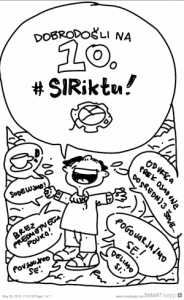Maja Kosmač Zamuda, ŠC Ljubljana
The article shows how to lead students through the process of learning during which all the students are active and autonomous. Students acquire more knowledge if they learn in the way and in the environment they like. This is precisely what the presented e-learning enables them to do. Thus, the teacher becomes the person who directs the process of learning with the materials that help students while learning. The students have become acquainted with the subject matter through the instructions I have prepared for them on the e-portfolio (http://mahara.org). E-portfolio is a students electronic space in which he/she plans, monitors and evaluates his/her learning at different stages. It is based on formative monitoring and evaluating of knowledge: thus, the skill of self-regulation of learning is stimulated as it anticipates the students cooperation and co-decision making in each and every part of the learning process. The students work has been divided into several units (Previous Knowledge, Planning of Learning, Achieving the Goals, Text Comprehension, Text Structure, Značajevka (a short story focused on the personality of the main character, specific to Slovenian literature), New Assignments and Self-Evaluation); the students shared their findings and notes with me via the sub-section My Learning (Evidence). In this way, I was able to monitor their work promptly at each stage. While working, they proved their previous knowledge by solving crossword puzzles and their autonomy in explaining literary concepts which they shared with their classmates on Padlet (http://padlet.com/); then they read the text and filled in the work sheet with which they proved their understanding of the literary text. They concluded their self-learning by being self-creative since they had to – based on the newly acquired knowledge – create an animation (http://www.powtoon.com/) on the character of the main character and watch the film which they commented upon in accordance with the received instructions; furthermore, they wrote a comparison with another already dealt with short story. Upon completion of the learning process, I made comments on their notes and materials to provide the students with feedback. Their findings were many-sided, very original since the text is short yet multifaceted and enables several possible interpretations and remakes. It is important that all the students were active and their knowledge better and more lasting than the knowledge of those students with whom I dealt with the subject matter in the classroom. It was the students themselves who realised that their knowledge is more permanent, which is evidenced by the survey (https://www.1ka.si/) in which they had taken part. Autonomous learning is relevant although in case of a complex subject matter the process is more time-consuming and therefore not suitable for every topic. When dealing with more complex topics it is well-advised for the teacher to select only a part of learning process which the students can acquire via autonomous learning on the e-portfolio.
